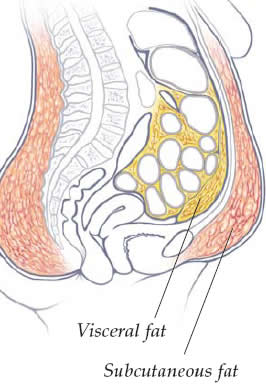Find out where visceral fat is located on your body and why it matters. Then learn the best way to get rid of the fat to slim down for better health.
Structure. Subcutaneous tissue consists of: Fibrous bands anchoring the skin to the deep fascia; Collagen and elastin fibers attaching it to the dermis; Fat, except in the eyelids, clitoris, penis, much of pinna, and scrotum

Do us a favor: Close your eyes and think of the word “fat.” What’s the first thing you see?
What Is Visceral Fat? Visceral fat is technically excess intra-abdominal adipose tissue accumulation. In other words, it’s known as a “deep” fat that’s stored further underneath the skin than “subcutaneous” belly fat.


Abdominal fat can be devious, gradually building up over your adult years until you suddenly have an unwanted pooch. Your body stores subcutaneous and visceral fat, both of which add inches to your waistline.

Visceral fat vs. Subcutaneous fat. Most know that having a large belly may be unhealthy. But did you know that not all belly fat is bad? Much of the fat in the stomach area lies directly under the skin.
Excess Abdominal Fat is Not Only Ugly, but Extremely Dangerous to Your Health – This is More Than a Vanity Issue! The difference between subcutaneous fat and the more deadly “visceral fat”


All fat is not created equal. Unsightly as it is, subcutaneous fat, the fat right under the skin, is not as dangerous to overall health as visceral fat, the fat deep in the belly surrounding vital organs.

Anatomical features. In humans, adipose tissue is located beneath the skin (subcutaneous fat), around internal organs (visceral fat), in bone marrow (yellow bone marrow), intermuscular (Muscular system) and in the breast tissue.

When people talk about wanting to burn belly fat, they are actually referring to two different types of fatty tissue: visceral fat (sometimes called active fat) and subcutaneous fat.

